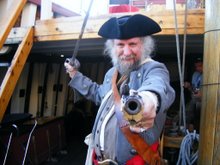Being at the whipstaff of the Half Moon was enlightening.
For those who are not familiar with the whipstaff, it was used to steer large ships during most of the 16th and 17th centuries. As recently as Columbus, ships had a single deck and were steered with a tiller. When additional decks were added, they added the whipstaff. The whipstaff it a pole with a collar that attaches to the tiller. There is a pivot point where it goes through the upper deck. The person at the helm pushes the whipstaff which then moves the tiller. This was, the helmsman can see out (at least to the sides) and, more importantly, can hear commands.
The hard thing about the whipstaff is which way you move it. Anyone who has used a tiller is used to moving the tiller right to turn left. This is switched with the whipstaff. You push it to the left to turn left.
There is an effort to moving the whipstaff. Also, if you push it all the way to one side then it slides down through the pivot and you have to pull it back up to center it again. An hour at the whipstaff is tiring.
At times the captain simply gives orders about how the ship should be steered - left 1/4, right 1/2, etc. Other times he would point to a landmark in the distance and ask that this be kept close to the port or starboard. At sea the captain would give a compass heading and the helmsman would use the compass in the binacle which is right in front of him. At these times he doesn't even need to see out.
The captain pointed out that the tiller doesn't really move much - maybe 15 degrees each way. The tiller acts more as a trim tab. The real work in turning the ship is done with the sprit sail and the mizzen. These pull the front or back the ship around.
The ship's wheel was invented around 1690 and became popular in the early 18th century. It had cables that went to the tiller. Turning the wheel pulls the cables, moving the tiller right or left. This has several advantages. The wheel can be mounted higher. Because of ratios, it cam make turning the ship easier. It can pull the tiller further to either side. And, it can be tied off as needed.
Regardless, steering the ship was not something that a captain normally did. In a tricky situation the captain would want to be mobile rather than stuck at one spot.
Subscribe to:
Post Comments (Atom)


No comments:
Post a Comment